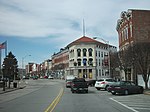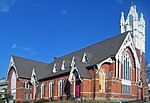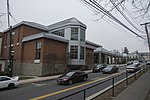Highland Cottage

Highland Cottage, also known as Squire House, is located on South Highland Avenue (U.S. Route 9) in Ossining, New York, United States. It was the first concrete house in Westchester County, built in the 1870s in the Gothic Revival architectural style. In 1982 it was listed on the National Register of Historic Places; almost 30 years later, it was added to the nearby Downtown Ossining Historic District as a contributing property.Built by a prominent local man with an interest in new construction techniques, it has seen several different uses over the years. It was a sanitarium in the early 20th century, then a hospital and later a restaurant. For most of that century, the Squire family ran a local business school there. Since then it has returned to residential use.
Excerpt from the Wikipedia article Highland Cottage (License: CC BY-SA 3.0, Authors, Images).Highland Cottage
South Highland Avenue,
Geographical coordinates (GPS) Address Nearby Places Show on map
Geographical coordinates (GPS)
| Latitude | Longitude |
|---|---|
| N 41.159602777778 ° | E -73.861269444444 ° |
Address
South Highland Avenue 36
10562
New York, United States
Open on Google Maps








